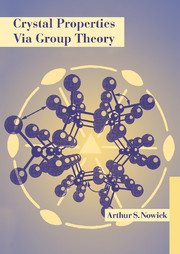Book contents
- Frontmatter
- Contents
- Preface
- 1 Tensor properties of crystals: equilibrium properties
- 2 Tensor properties of crystals: transport properties
- 3 Review of group theory
- 4 Linear relations treated group theoretically
- 5 The magnetic point groups and time reversal
- 6 Matter tensors of rank 0, 1 and 2
- 7 Matter tensors of rank 3
- 8 Special magnetic properties
- 9 Matter tensors of ranks 4 and 5
- 10 Matter tensors of rank 6
- Appendices
- A Review of tensors
- B Stress, strain and elasticity
- C Finite deformation
- D The great orthogonality theorem
- E The Symmetry-Coordinate Transformation tables for the 32 point groups and two infinite groups
- F Proof of the Fundamental Theorem
- G Theorems concerning magnetic groups
- References
- Index
10 - Matter tensors of rank 6
Published online by Cambridge University Press: 18 December 2009
- Frontmatter
- Contents
- Preface
- 1 Tensor properties of crystals: equilibrium properties
- 2 Tensor properties of crystals: transport properties
- 3 Review of group theory
- 4 Linear relations treated group theoretically
- 5 The magnetic point groups and time reversal
- 6 Matter tensors of rank 0, 1 and 2
- 7 Matter tensors of rank 3
- 8 Special magnetic properties
- 9 Matter tensors of ranks 4 and 5
- 10 Matter tensors of rank 6
- Appendices
- A Review of tensors
- B Stress, strain and elasticity
- C Finite deformation
- D The great orthogonality theorem
- E The Symmetry-Coordinate Transformation tables for the 32 point groups and two infinite groups
- F Proof of the Fundamental Theorem
- G Theorems concerning magnetic groups
- References
- Index
Summary
The only matter tensor having a rank as high as 6 that appears in Chapters 1 and 2 is the so-called ‘third-order elastic constant’ tensor of type Ts(6). (See Section 1–6 and Table 1–1.) This tensor couples a quantity Y, which is a thermodynamic tension, ti, of type Ts(2) to a quantity X, which is the symmetric product of Lagrangian strains, ηiηi, of type Ts(4). (Here, both ti and ηj are second-rank symmetric tensors whose six components are written in single-index hypervector notation.) The resulting matter tensor K is then a Ts(6) tensor, symmetric in the interchange of all the indices. The first objective of this chapter will be to obtain the independent components of such a Ts(6) tensor. This will require us to go beyond the material contained in the S-C-T tables (Appendix E).
Relation betweenTs(2) andTs(4)
We wish to consider the usual relation: Y = KX, in which Y is a Ts(2) tensor that transforms as a six-vector, and X is a Ts(4) tensor which transforms as the 21 symmetric products of six-vectors, αiαj. (Here we use the notation α for a Ts(2) tensor as in the S-C-T tables and Eq. (4–4).) In terms of the single-index quantities Y and X, K then become a two-index (6 × 21) matrix.
- Type
- Chapter
- Information
- Crystal Properties via Group Theory , pp. 173 - 191Publisher: Cambridge University PressPrint publication year: 1995

